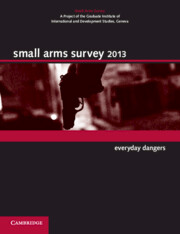Book contents
- Frontmatter
- Foreword
- Contents
- About the Small Arms Survey
- Notes to readers
- Acknowledgements
- Introduction
- Chapter 1 Everyday Dangers: Non-conflict Armed Violence
- Chapter 2 Too Close to Home: Guns and Intimate Partner Violence
- Chapter 3 Turning Points: Gang Evolution in Nicaragua
- Chapter 4 Guns in the Family: Mafia Violence in Italy
- Chapter 5 Survival at Stake: Violent Land Conflict in Africa
- Chapter 6 Trend Lines: Armed Violence in South Africa pages 132 to 137
- Chapter 6 Trend Lines: Armed Violence in South Africa pages 137 to 159
- Chapter 7 Second Wind: The PoA's 2012 Review Conference pages 160 to 168
- Chapter 7 Second Wind: The PoA's 2012 Review Conference pages 169 to 177
- Chapter 8 Trade Update: Authorized Small Arms Transfers
- Chapter 9 Burning the Bullet: Industrial Demilitarization of Ammunition pages 186 to 199
- Chapter 9 Burning the Bullet: Industrial Demilitarization of Ammunition pages 200 to 217
- Chapter 10 ‘Infernal Machines’: Improvised Explosive Devices
- Chapter 11 Price Watch: Arms and Ammunition at Illicit Markets pages 250 to 268
- Chapter 11 Price Watch: Arms and Ammunition at Illicit Markets pages 269 to 281
- Chapter 12 Captured and Counted: Illicit Weapons in Mexico and the Philippines pages 282 to 302
- Chapter 12 Captured and Counted: Illicit Weapons in Mexico and the Philippines pages 302 to 317
- Index
Chapter 7 - Second Wind: The PoA's 2012 Review Conference pages 160 to 168
Published online by Cambridge University Press: 05 June 2014
- Frontmatter
- Foreword
- Contents
- About the Small Arms Survey
- Notes to readers
- Acknowledgements
- Introduction
- Chapter 1 Everyday Dangers: Non-conflict Armed Violence
- Chapter 2 Too Close to Home: Guns and Intimate Partner Violence
- Chapter 3 Turning Points: Gang Evolution in Nicaragua
- Chapter 4 Guns in the Family: Mafia Violence in Italy
- Chapter 5 Survival at Stake: Violent Land Conflict in Africa
- Chapter 6 Trend Lines: Armed Violence in South Africa pages 132 to 137
- Chapter 6 Trend Lines: Armed Violence in South Africa pages 137 to 159
- Chapter 7 Second Wind: The PoA's 2012 Review Conference pages 160 to 168
- Chapter 7 Second Wind: The PoA's 2012 Review Conference pages 169 to 177
- Chapter 8 Trade Update: Authorized Small Arms Transfers
- Chapter 9 Burning the Bullet: Industrial Demilitarization of Ammunition pages 186 to 199
- Chapter 9 Burning the Bullet: Industrial Demilitarization of Ammunition pages 200 to 217
- Chapter 10 ‘Infernal Machines’: Improvised Explosive Devices
- Chapter 11 Price Watch: Arms and Ammunition at Illicit Markets pages 250 to 268
- Chapter 11 Price Watch: Arms and Ammunition at Illicit Markets pages 269 to 281
- Chapter 12 Captured and Counted: Illicit Weapons in Mexico and the Philippines pages 282 to 302
- Chapter 12 Captured and Counted: Illicit Weapons in Mexico and the Philippines pages 302 to 317
- Index
Summary
INTRODUCTION
All fired up. Nothing to do. The Second Review Conference (RevCon) for the UN Programme of Action (PoA) faced the same problem that had helped to sink its predecessor, namely how to make sense of a mandate that required it ‘to review progress made’ in PoA implementation when there was no mechanism to do so.
This chapter explains how the Second Review Conference, despite such uncertainty, managed to achieve a result that holds out the promise of a strengthened PoA. Drawing on relevant UN documents and the author's own observations of the meeting and its preparatory phase, the chapter examines the principal features of the Review Conference process and outcome. Its main conclusions include the following:
• The Second Review Conference avoided many of the problems that plagued the First Review Conference, largely through the use of a working method that contributed to the success of UN small arms meetings after 2006.
• The Review Conference outcome is forward-looking, setting out a series of measures intended to bolster implementation of the PoA and the International Tracing Instrument (ITI) during the next six-year meeting cycle.
• While the Review Conference text draws on the conclusions of preceding PoA meetings, overall it has little to say about ‘progress made’ in PoA and ITI implementation, reflecting the lack of formal monitoring tools.
• The Review Conference outcome raises the possibility of increased attention to longer-term trends in small arms proliferation and misuse, including the related question of PoA and ITI effectiveness.
[…]
- Type
- Chapter
- Information
- Small Arms Survey 2013Everyday Dangers, pp. 160 - 168Publisher: Cambridge University PressPrint publication year: 2013



